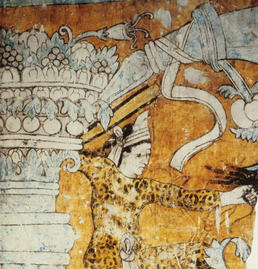Subproject 1: Images of Alterity – Alterity of Images. Artistic processes of transcultural negotiation between New Spain and Europe in the 16th century
(Dr. Julia Kloss-Weber)
In the 16th century, the Franciscans, Dominicans and Augustinians established monasteries in New Spain. Unlike earlier scholarship, Subproject 1 starts from the assumption that phenomena of glocalization can be observed in the art production of all three orders and that it is even possible to distinguish characteristics specific to each order with regard to the media and iconographies employed. Both the Christian monks and the other actors in colonial society had evidently developed a keen sense of the processes that we today term processes of cultural negotiation.
The aim is therefore to show that, in image production in 16th-century New Spain, pictorial themes that contained semantics of the overcoming of alterity, and which directly reflected the experience of cultural contact, made an increasing appearance. However, the formulation “Images of Alterity” in the subproject’s title addresses not only the semantic and iconographic dimensions of such works, but refers equally to their visual rhetoric and formal aesthetics. In other words, the study focuses upon pictorial formulae in which translations of visual cultures are consciously enacted, and upon visual forms that thematize constructions and shifts of alterity and difference on a medial level, too. Transcultural spaces of negotiation can be experienced directly as built and painted spaces, or materialize in a performative manner through an active process of translation. On the basis of the case studies, we shall also describe how formal structures and the painterly concretion and medial presence of the works can, on occasions, even open up opposite readings of iconographical content. The subproject thereby predominantly looks at visual forms that are distinguished by a particular ambiguity, since their performative potential resides in the interstices between the parameters of image and space, image and body, and image and word.
Since the media not only undergo processes of translation themselves but also make these processes their theme, it seems logical to view transcultural translation as a mode of visuality or representation and to ask whether there is a relationship, for example, between transcultural and transmedial dynamics. From the perspective of this subproject, the thesis that artistic forms of expression, and specifically visual media, play a particular role within the framework of transcultural processes of negotiation, can only be sufficiently substantiated if we first succeed in outlining the transcultural potential of images themselves. To this end, categories such as alterity and liminality shall be purposely discussed at the interface of visual theory and postcolonial debates. Is there an “alterity of images?” Can a transcultural aesthetic and/or an aesthetic of the transcultural be sketched – at least in part – in this way?


